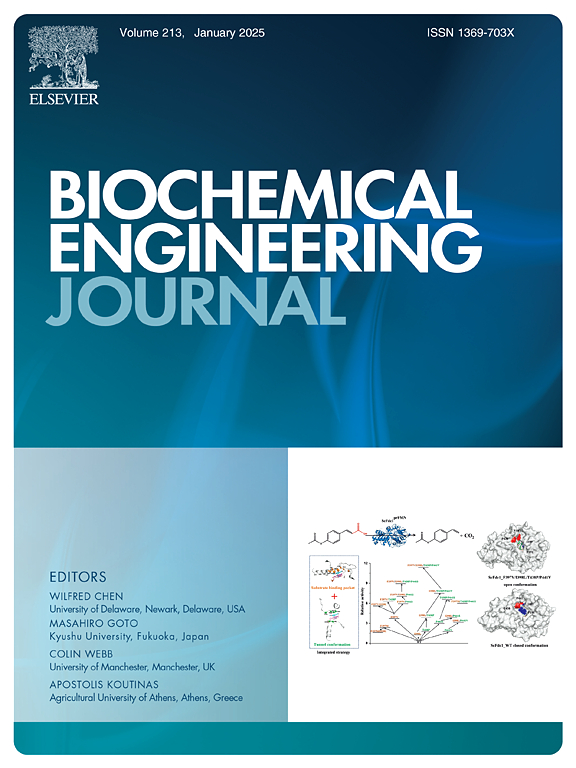Effective expression of taste-modifying protein miraculin fusing FMDV 2A gene in Chlamydomonas reinhardtii
IF 3.7
3区 生物学
Q2 BIOTECHNOLOGY & APPLIED MICROBIOLOGY
引用次数: 0
Abstract
Miraculin is a taste modification protein derived from plants, which can change sour taste into sweet taste, and has great application potential in food industry. Currently, the extraction of miraculin presented some problems such as cumbersome process and low purity. Chlamydomonas reinhardtii is a potential expression system of exogenous proteins. However, the exogenous genes are integrated randomly in genome of C. reinhardtii during transformation, which leads to significant expression variability among transformants. The 2A peptide from FMDV virus has been proven to effectively improve the expression efficiency of exogenous proteins in multi-gene expression systems through self-cleavage mechanism. In presented study, the expression vector pSP108–2A-miraculin containing 2A-miraculin fusion gene was constructed and transformed into C. reinhardtii by glass bead method. Two positive strains were obtained through bleomycin resistance selecting. The detection results showed that miraculin gene was integrated into the genome of C. reinhardtii cells at the molecular level, and was successfully expressed at the protein level. This study was the first time to express the miraculin in C. reinhardtii, which provided an optional way to obtain miraculin.
融合FMDV 2A基因的味觉修饰蛋白miraculin在莱茵衣藻中的有效表达
神奇果蛋白是一种从植物中提取的味觉修饰蛋白,能将酸味转变为甜味,在食品工业中具有很大的应用潜力。目前,奇迹般蛋白的提取存在工艺繁琐、纯度低等问题。莱茵衣藻是一种潜在的外源蛋白表达系统。然而,外源基因在转化过程中是随机整合到莱茵哈蒂菌基因组中的,这导致了突变体间表达的显著差异。FMDV病毒2A肽已被证实通过自裂机制有效提高外源蛋白在多基因表达系统中的表达效率。本研究构建了含有2A-miraculin融合基因的表达载体pSP108-2A-miraculin,并采用玻璃球法将其转化为莱茵弧菌。通过博来霉素耐药筛选获得2株阳性菌株。检测结果表明,miraculin基因在分子水平上被整合到C. reinhardtii细胞的基因组中,并在蛋白水平上成功表达。本研究首次在C. reinhardtii中表达了miracle ulin,为获得miracle ulin提供了一种可选的途径。
本文章由计算机程序翻译,如有差异,请以英文原文为准。
求助全文
约1分钟内获得全文
求助全文
来源期刊

Biochemical Engineering Journal
工程技术-工程:化工
CiteScore
7.10
自引率
5.10%
发文量
380
审稿时长
34 days
期刊介绍:
The Biochemical Engineering Journal aims to promote progress in the crucial chemical engineering aspects of the development of biological processes associated with everything from raw materials preparation to product recovery relevant to industries as diverse as medical/healthcare, industrial biotechnology, and environmental biotechnology.
The Journal welcomes full length original research papers, short communications, and review papers* in the following research fields:
Biocatalysis (enzyme or microbial) and biotransformations, including immobilized biocatalyst preparation and kinetics
Biosensors and Biodevices including biofabrication and novel fuel cell development
Bioseparations including scale-up and protein refolding/renaturation
Environmental Bioengineering including bioconversion, bioremediation, and microbial fuel cells
Bioreactor Systems including characterization, optimization and scale-up
Bioresources and Biorefinery Engineering including biomass conversion, biofuels, bioenergy, and optimization
Industrial Biotechnology including specialty chemicals, platform chemicals and neutraceuticals
Biomaterials and Tissue Engineering including bioartificial organs, cell encapsulation, and controlled release
Cell Culture Engineering (plant, animal or insect cells) including viral vectors, monoclonal antibodies, recombinant proteins, vaccines, and secondary metabolites
Cell Therapies and Stem Cells including pluripotent, mesenchymal and hematopoietic stem cells; immunotherapies; tissue-specific differentiation; and cryopreservation
Metabolic Engineering, Systems and Synthetic Biology including OMICS, bioinformatics, in silico biology, and metabolic flux analysis
Protein Engineering including enzyme engineering and directed evolution.
 求助内容:
求助内容: 应助结果提醒方式:
应助结果提醒方式:


